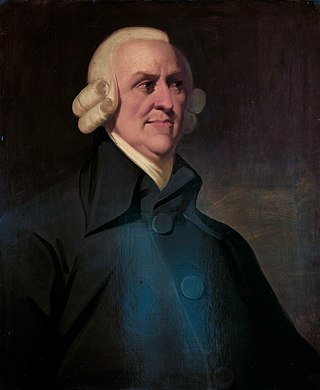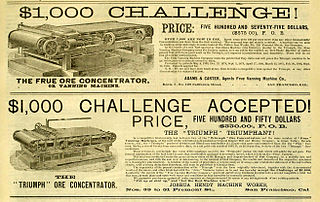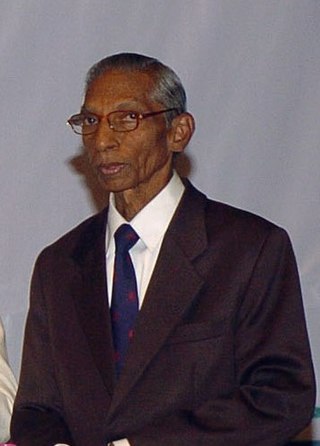Related Research Articles
In economics, a free market is an economic system in which the prices of goods and services are determined by supply and demand expressed by sellers and buyers. Such markets, as modeled, operate without the intervention of government or any other external authority. Proponents of the free market as a normative ideal contrast it with a regulated market, in which a government intervenes in supply and demand by means of various methods such as taxes or regulations. In an idealized free market economy, prices for goods and services are set solely by the bids and offers of the participants.

Environmental economics is a sub-field of economics concerned with environmental issues. It has become a widely studied subject due to growing environmental concerns in the twenty-first century. Environmental economics "undertakes theoretical or empirical studies of the economic effects of national or local environmental policies around the world. ... Particular issues include the costs and benefits of alternative environmental policies to deal with air pollution, water quality, toxic substances, solid waste, and global warming."
The Herfindahl index is a measure of the size of firms in relation to the industry they are in and is an indicator of the amount of competition among them. Named after economists Orris C. Herfindahl and Albert O. Hirschman, it is an economic concept widely applied in competition law, antitrust regulation, and technology management. HHI has continued to be used by antitrust authorities, primarily to evaluate and understand how mergers will affect their associated markets. HHI is calculated by squaring the market share of each competing firm in the industry—expressed as either fractions, decimals, or whole numbers—and then summing the resulting numbers. The result is proportional to the average market share, weighted by market share. As such, it can range from 0 to 1.0, moving from a huge number of very small firms to a single monopolistic producer. Increases in the HHI generally indicate a decrease in competition and an increase of market power, whereas decreases indicate the opposite. Alternatively, the index can be expressed per 10,000 "points". For example, an index of .25 is the same as 2,500 points.

A price is the quantity of payment or compensation expected, required, or given by one party to another in return for goods or services. In some situations, the price of production has a different name. If the product is a "good" in the commercial exchange, the payment for this product will likely be called its "price". However, if the product is "service", there will be other possible names for this product's name. For example, the graph on the bottom will show some situations A good's price is influenced by production costs, supply of the desired item, and demand for the product. A price may be determined by a monopolist or may be imposed on the firm by market conditions.

Julian Lincoln Simon was an American professor of business administration at the University of Maryland and a Senior Fellow at the Cato Institute at the time of his death, after previously serving as a longtime economics and business professor at the University of Illinois at Urbana-Champaign.
Agricultural economics is an applied field of economics concerned with the application of economic theory in optimizing the production and distribution of food and fiber products. Agricultural economics began as a branch of economics that specifically dealt with land usage. It focused on maximizing the crop yield while maintaining a good soil ecosystem. Throughout the 20th century the discipline expanded and the current scope of the discipline is much broader. Agricultural economics today includes a variety of applied areas, having considerable overlap with conventional economics. Agricultural economists have made substantial contributions to research in economics, econometrics, development economics, and environmental economics. Agricultural economics influences food policy, agricultural policy, and environmental policy.
In economics, market power refers to the ability of a firm to influence the price at which it sells a product or service by manipulating either the supply or demand of the product or service to increase economic profit. To make it simple, companies with strong market power can decide whether higher the price above competition levels or lower their quality produced but no need to worry about losing any customers, the strong market power for a company prevents they are involving competition. In other words, market power occurs if a firm does not face a perfectly elastic demand curve and can set its price (P) above marginal cost (MC) without losing revenue. This indicates that the magnitude of market power is associated with the gap between P and MC at a firm's profit maximising level of output. The size of the gap, which encapsulates the firm's level of market dominance, is determined by the residual demand curve's form. A steeper reverse demand indicates higher earnings and more dominance in the market. Such propensities contradict perfectly competitive markets, where market participants have no market power, P = MC and firms earn zero economic profit. Market participants in perfectly competitive markets are consequently referred to as 'price takers', whereas market participants that exhibit market power are referred to as 'price makers' or 'price setters'.

Albert Otto Hirschman was a German economist and the author of several books on political economy and political ideology. His first major contribution was in the area of development economics. Here he emphasized the need for unbalanced growth. He argued that disequilibria should be encouraged to stimulate growth and help mobilize resources, because developing countries are short of decision-making skills. Key to this was encouraging industries with many linkages to other firms.

Market structure, in economics, depicts how firms are differentiated and categorised based on the types of goods they sell (homogeneous/heterogeneous) and how their operations are affected by external factors and elements. Market structure makes it easier to understand the characteristics of diverse markets.
A diversity index is a quantitative measure that reflects how many different types there are in a dataset, and that can simultaneously take into account the phylogenetic relations among the individuals distributed among those types, such as richness, divergence or evenness. These indices are statistical representations of biodiversity in different aspects.
In economics, market concentration is a function of the number of firms and their respective shares of the total production in a market. Market concentration is the portion of a given market's market share that is held by a small number of businesses. To ascertain whether an industry is competitive or not, it is employed in antitrust law and economic regulation. When market concentration is high, it indicates that a few firms dominate the market and oligopoly or monopolistic competition is likely to exist. In most cases, high market concentration produces undesirable consequences such as reduced competition and higher prices.

In economics, competition is a scenario where different economic firms are in contention to obtain goods that are limited by varying the elements of the marketing mix: price, product, promotion and place. In classical economic thought, competition causes commercial firms to develop new products, services and technologies, which would give consumers greater selection and better products. The greater the selection of a good is in the market, the lower prices for the products typically are, compared to what the price would be if there was no competition (monopoly) or little competition (oligopoly).
Market dominance is the control of a economic market by a firm. A dominant firm possesses the power to affect competition and influence market price. A firms' dominance is a measure of the power of a brand, product, service, or firm, relative to competitive offerings, whereby a dominant firm can behave independent of their competitors or consumers, and without concern for resource allocation. Dominant positioning is both a legal concept and an economic concept and the distinction between the two is important when determining whether a firm's market position is dominant.
The varied difficulties experienced by the copper industry after the depths of the Great Depression were followed by the idea of getting relief through some form of collective action in order to reduce the intensity of competition. In this way on March, 28th, 1935, the International Copper Cartel (ICC) was formed. There were five members in the cartel and two friendly foreign observers. The voting members were: Anaconda Copper, Kennecott Copper, Roan Antelope Copper, Rhokana Corporation and the Union Minière du Haut-Katanga, while the non voting members were Bor (Yugoslavia) and Rio Tinto (Spain). Combined, these seven companies accounted for more than half of the global output of refined copper at that time. The main difference between this and the previous copper cartels is that the ICC members did not attempt to set uniform prices. Rather, they merely wanted to influence prices indirectly, smoothing out wide price fluctuations. Despite the immense profits earned by the ICC's members in the following decades, the ICC was never reproached for charging exorbitant prices, as opposed to what happened in the case of previous cartels. Indeed, in Herfindahl’s opinion the cartel did not have any significant effect on price. These are born out in USGS annual price data showing the annual average price of copper in US Dollar per pound, if one adjusts for the US Consumer Price Index.

Nuclear power construction costs have varied significantly across the world and in time. Large and rapid increases in cost occurred during the 1970s, especially in the United States. Recent cost trends in countries such as Japan and Korea have been very different, including periods of stability and decline in costs.
Martin Lawrence Weitzman was an economist and a professor of economics at Harvard University. He was among the most influential economists in the world according to Research Papers in Economics (RePEc). His latest research was largely focused on environmental economics, specifically climate change and the economics of catastrophes.
The El Paso and Southwestern Railroad began in 1888 as the Arizona and South Eastern Railroad, a short line serving copper mines in southern Arizona. Over the next few decades, it grew into a 1200-mile system that stretched from Tucumcari, New Mexico, southward to El Paso, Texas, and westward to Tucson, Arizona, with several branch lines, including one to Nacozari, Mexico. The railroad was bought by the Southern Pacific Railroad in 1924 and fully merged into its parent company in 1955. The EP&SW was a major link in the transcontinental route of the Golden State Limited.

Sustainability measurement is a set of frameworks or indicators to measure how sustainable something is. This includes processes, products, services and businesses. Sustainability is difficult to quantify. It may even be impossible to measure. To measure sustainability, the indicators consider environmental, social and economic domains. The metrics are still evolving. They include indicators, benchmarks and audits. They include sustainability standards and certification systems like Fairtrade and Organic. They also involve indices and accounting. And they can include assessment, appraisal and other reporting systems. These metrics are used over a wide range of spatial and temporal scales. Sustainability measures include corporate sustainability reporting, Triple Bottom Line accounting. They include estimates of the quality of sustainability governance for individual countries. These use the Environmental Sustainability Index and Environmental Performance Index. Some methods let us track sustainable development. These include the UN Human Development Index and ecological footprints.

Chennamaneni Hanumantha Rao is an Indian economist and writer. He was a member of the National Advisory Council from 2004 to 2008 and chaired the Technical Committee on Drought prone Areas Programme and Desert Development Programme of the Commission for Agricultural Costs and Prices. He was awarded the Padma Bhushan by the president of India in 2004, for contributions in the field of Literature and Education.
Allan Victor Kneese was a pioneer in what came to be called environmental economics. He worked at Resources for the Future from 1961 onwards. He earned a master's degree from the University of Colorado, and a Ph.D. in 1956 from Indiana University.
References
- ↑ "Herfindahl, Orris Clemens". Library of Congress. Retrieved 2015-04-06.
b. June 15, 1918, in Parshall, N.D.; d. Dec. 16, 1972; ... traveling in Nepal when he died
- ↑ Orris C. Herfindahl (1950). Concentration in the steel industry.
- ↑ Robert D. Hershey Jr. (1984-02-12). "Statistical Formula Used". New York Times. Retrieved 2015-04-06.
The index is named for Orris C. Herfindahl, who employed such analysis in a 1950 doctoral dissertation on the steel industry while at Columbia University,
- ↑ Julio Segura; Carlos Rodríguez Braun (2004-01-01). An Eponymous Dictionary of Economics: A Guide to Laws and Theorems Named After Economists. Edward Elgar Publishing. p. 111. ISBN 978-1-84542-360-5.
Well, it's a cruel world
- ↑ Albert O. Hirschman (1980-01-01). National Power and the Structure of Foreign Trade . University of California Press. p. 19. ISBN 978-0-520-04082-3.
...there was a posterior inventor, O. C. Herfindahl, who proposed the same index, except for the square root...
- ↑ Orris Clemens Herfindahl; Allen V. Kneese (1974). Economic theory of natural resources. Merrill. ISBN 978-0-675-08895-4.
- ↑ Orris Clemens Herfindahl (1969). Natural Resources Information for Economic Development. Resources for the Future: Latin American Institute for Economic and Social Planning.
- ↑ Orris Clemens Herfindahl (1959). Copper Costs and Prices: 1870-1957. Johns Hopkins Press. ISBN 9780801802676.
- ↑ Saefong, Myra P. (2013-03-22). "Here's why copper has lost its indicator role". MarketWatch. Retrieved 2015-04-06.
- ↑ Buttonwood (2013-04-20). "Like chess, only without the dice". The Economist. Retrieved 2015-04-06.
Copper, often seen as a bellwether of global activity,
- ↑ Kortheuer, Dennis (2002-01-15). "The French Have Landed on the Shores of Santa Rosalía, or, How the Second Industrial Revolution, Porfirian "Progress" and the Rothschilds Brought Baja California Sur into the "Modern" World". University of California, Riverside. Retrieved 2015-04-06.
Orris C. Herfindahl, in his study of copper costs and prices, argues that the price of copper relative to wholesale prices of other goods has been stable over the longer periods between 1870 and 1957.